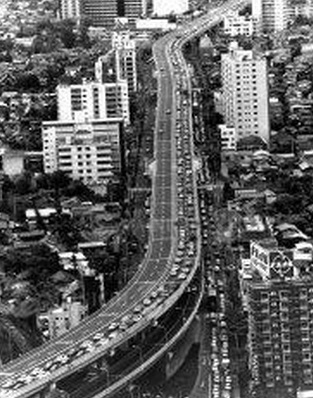Section 3. Responding to Emissions Controls
Item 1. Issue of Emissions Arises
In the 1970s, atmospheric pollution became a significant social issue, particularly in major cities such as Tokyo. As a result, moves to tighten regulations on automobile emissions as well as pollutants generated by factories and electric power plants increased.
Atmospheric pollution became an issue in the United States much earlier than in Japan. Smog occurred in Los Angeles, California as early as 1943.1 Later, it was discovered that smog consists of oxidants generated from hydrocarbons (HCS) and nitrogen dioxide (NO2). U.S. automobile emissions controls started with crankcase emissions regulations adopted in 1962 by California, which went on to adopt vehicle emissions regulations in 1965.
On the U.S. national level, the Clean Air Act was adopted in 1963, and controls on atmospheric pollutants were steadily tightened including the implementation of national emissions regulations in 1968. The Muskie Act (the Clean Air Act of 1970), which was adopted in December 1970, included the following provisions concerning automobile emissions:
- 1.Starting with 1975 model-year vehicles, HC and carbon monoxide (CO) emissions are to be limited to one-tenth the 1970 regulatory level.
- 2.Starting with 1976 model-year vehicles, nitrogen oxide (NOX) emissions are to be limited to one-tenth the average for 1971 model-year vehicles.
In August 1967, Japan adopted the Pollution Countermeasures Basic Law, followed by the Air Pollution Prevention Law in June 1968. Under these laws, it became obligatory to reduce CO emissions to three percent or less of automobile exhaust.
Regulation of HC essentially began in 1970, and in September of that year, installation of blow-by gas reduction devices2 on new vehicles became mandatory. In July, the Council for Transport Technology submitted a report entitled "Automobile Emissions Countermeasures Basic Plan," and based on this plan, Japan's 1973 Emissions Control Standards were announced in December 1972 followed by the 1973 Emissions Controls Concerning In-Use Vehicles regulation in January 1973.
There were reports in May 1970 that testing had detected extremely high concentrations of lead in the blood of residents living near the Ushigome-Yanagi-cho intersection in Shinjuku-ku, Tokyo. The following June, the Tokyo Metropolitan Government Bureau of Public Health denied the reports, stating that there was no lead contamination detected in residents' tests, but the lead used in gasoline came under close scrutiny and concerns regarding automobile emissions increased. In July, more than 40 girls at a high school in Suginami-ku, Tokyo were overcome by a difficulty to breath, dizziness and nausea. The cause of the incident was said to be photochemical smog and emissions from waste incinerators, but there was also a theory that it was psychosomatic. Nonetheless, automobile emissions became a widely discussed social issue as a result of this incident, and the regulation of emissions was tightened even further.
Japan's Environment Agency was established in July 1971. Also, that September, the Central Council for Environmental Pollution Control was formed as an advisory panel to the director-general of the Environment Agency.


